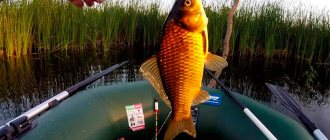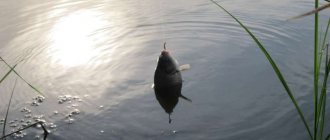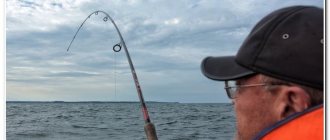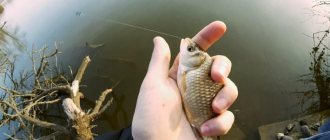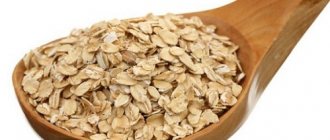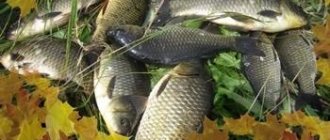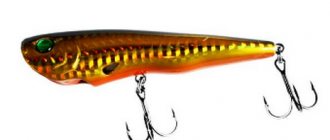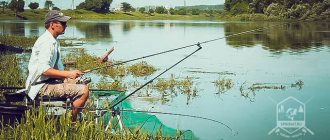Is it possible to catch crucian carp using a spinning rod?
Spinning is used to catch predatory species of river fish, but recently, due to the emergence of a huge number of different gear and baits, catching crucian carp using this device has become popular. The main thing is to choose the right equipment for spinning. Although some fishermen prefer to use a float rod the old fashioned way.
Crucian carp, like many other small river fish, are wonderfully caught using spinning rods, especially if you choose the right place for fishing. It is imperative to take into account the leisurely lifestyle of this river inhabitant. This fish gets food from the muddy bottom of the river, so the bait should sink closer to the bottom of the reservoir. Accordingly, bottom fishing techniques are used.
Did you know? The Germans call crucian carp "peasant carp".
Features of gear
Tackle for spinning carp fishing has the necessary strength, but at the same time their camouflage must be at a high level. When the carp is not actively searching for food due to a slow metabolism, it needs to be offered an appetizing bait that is difficult to refuse.
Artificial baits are used when fishing for carp and grass carp in the summer and these are:
- dip plastic corn;
- plastic imitations of dumbbells;
- plastic boilies;
- foam balls;
- artificial flies;
- attachments for zig-rig fishing.
But even in the fall, fish respond with pleasure to silicone baits, especially if they are flavored with a tasty dip, or plasma gel was used to increase attraction.
Where and when to fish
Crucian carp, due to their measured and slow lifestyle, does not quickly respond to bait. But other river fish (for example, perch) are more active and get hooked more often, so it is important to choose the right area of the reservoir where crucian carp are found. They prefer to live in small lakes with peaceful neighbors. A pond with a lot of “spots” and “palms” weighing up to 200 grams is perfect.

Attention should be paid to the demarcation line between water and vegetation. Places with reeds are good.
If there are predatory fish on a section of a river or in a reservoir, then it is better not to look for crucian carp there. Predators will react faster to the bait and will scare away smaller and timid fish. It is worth looking for differences in depth (slopes, edges) where there is vegetation.
Also find out how to salt crucian carp on a ram at home.
To get a big catch, be sure to pay attention to the weather. In hot weather, the fish in question is not active, and in cold weather it goes to depths where it is difficult to find. Therefore, it is better to fish in warm weather. In the morning and evening, the crucian carp will stick to the bottom, and in the daytime it may end up at different levels, including on the surface.
In autumn, crucian carp bite until frost, but not as actively as in summer. It is difficult to catch it in winter, as it goes deep and is inactive. Fishing should begin no earlier than the ice melts from the river.
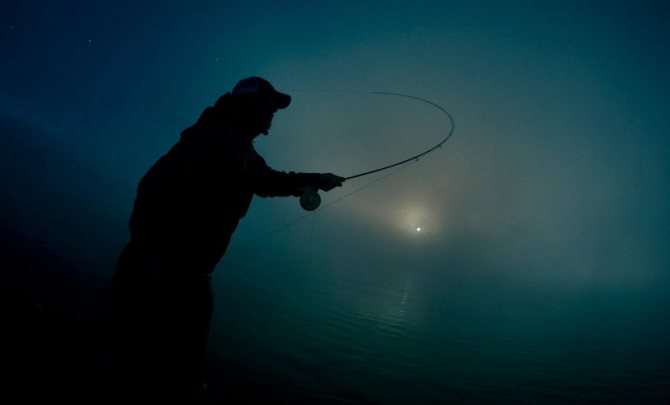
In hot weather, it is better to catch this fish at night.
At the beginning of spring, fishing is more promising in shallow water, near the shore, where crucian carp appear immediately after wintering in search of food. During this period, you need to pay attention to areas of the reservoir with remnants of vegetation from last year. Spring fishing is the most effective, as the fish are active in order to obtain food. In summer, it is better to pay attention to holes with a depth of 1–2 meters and creeks that are protected from gusts of wind.
Important! Please note that when catching crucian carp you need to constantly change the place. Several casts can alert river inhabitants, so you need to move a little to the side.
Fishing gear
When fishing for carp with a spinning rod on the river, you use tackle with retractable leads and 10-15 g weights, which allow you to perform a comfortable cast. The hook is selected according to the size of the plastic bait; it must be very sharp and durable. There are cases when large carp left during fishing only because a low-quality hook was used.
Important! Don’t forget to check the sharpness of the hook before casting, this will help improve your fishing performance with a spinning rod.
Lures for spinning fishing
Crucian carp have a small mouth, so the bait should be small and narrow. When using a spinning rod, choose spinning baits made of silicone up to 2 cm in size, which resemble worms, leeches, crustaceans, maggots, and bloodworms. Twisters and slugs are perfect.

The combination of baits of animal and plant origin gives the best results.
Out of caution, crucian carp always first tries the bait and, if nothing repels it, swallows it, so you need to choose edible silicone. Fragrances are often applied to baits to attract fish. They are also equipped with jig heads weighing up to 4 g. Meat baits - maggots, bloodworms, worms and larvae - are also good. Vegetable options include corn (boiled or canned), barley or millet porridge, and bread crumbs.
Important! It is necessary to ensure that the bait is not bright and has a natural color suitable for the habitat of the described aquatic inhabitants.
When choosing bait, you need to take into account seasonality. In summer, fish prefer vegetable baits, and in spring and autumn - meat baits. Carp or carp will be able to bite on bait for crucian carp, but only small specimens.
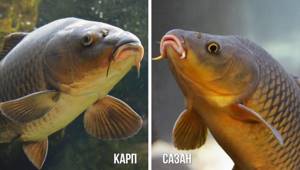
Bait
In summer, carp are actively fed in order to attract them to the place where the hook with the nozzle is located. Fish move around a body of water in search of food and will most likely respond to the smell of tasty bait. In autumn there is no such need, and bait will not be as effective as in summer.

Moreover, unnatural smells can scare away large fish that are preparing for winter and are very cautious. So there is no need to feed carp when fishing with a spinning rod in the fall. But it won’t hurt to treat the bait with a spray or dip, this increases the chance of a fish biting.
How to equip a spinning rod for crucian carp
To catch such small fish you need a sensitive rod, so it is not at all necessary to take a long spinning rod. You should select a suitable reel, fishing line, the desired number of hooks and sinkers. If you collect your gear correctly, it will make your fishing more successful.
Pay attention to how to stew crucian carp in a frying pan and in a slow cooker.
Rod selection
For catching crucian carp, a sufficient length of spinning rod will be 2.4 m with a test load of up to 5–7 g. An ultralight rod with a monolithic and flexible Solid Tip tip is suitable. It must have a fast or ultra-fast action, so it is better to abandon telescopic options. However, you can also use composite materials: although they are heavier, they are resistant to damage.
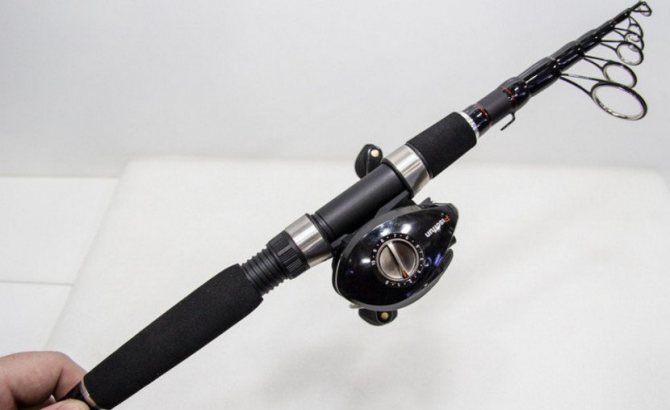
A carbon fiber product would work well. Its lightness and short length will guarantee high sensitivity.
fishing line
The rod should be equipped with ultralight or light braid with a cross section of 0.1–0.2 mm. It is durable, low-stretch and responds faster to bites. Its disadvantages are its higher price and the fact that it is more difficult to untangle.
Did you know? For thousands of years, fishing lines were made from horsehair, and sometimes from cotton or linen thread.
The very first artificial material for them was nylon, invented in 1937 by scientists from an American laboratory. It is better to use fluorocarbon for a leash, as it is almost invisible in the water and will not scare away the fish. In addition, it is stronger, and the likelihood of large fish biting this tackle is excluded. Its length can be up to 0.5–1 m. It is enough if the tensile strength of the fishing line is 3 kg.
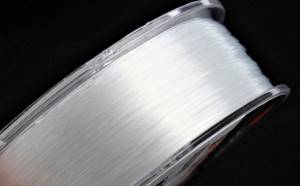
Coil
A small spinning reel of size 1000–2000 is suitable for a spinning rod with an ultralight rod. It fully matches this type of rod and line. The friction brake must be of good quality and smoothly adjustable to prevent the fish from trying to get off the hook. The crucian carp may be small in size, but it will resist to the end.
Here you can read about how to deliciously cook crucian carp in the oven.
You can take a non-inertia-free version of the reel, the main thing is that it is small in size and has ease of winding and adjustment of the friction brake.

Hook
For small fish, it is enough to purchase single hooks No. 3.5–7 (according to domestic numbering) with a standard shank. Its sting should be slightly bent inward, since with this shape it is more convenient to hook fish. For a crucian carp weighing only 200 g, a hook No. 3.5 is sufficient, and for a half-kilogram individual you will need No. 5–7.
Did you know? Crucian carp have an excellent sense of smell and notice parts per million of substances secreted by the inhabitants of the reservoir. They are also real drug addicts who can be lured by the smell of garlic, fragrant edible oil, Corvalol, valerian or even kerosene.
They are attached to a leash 10–15 cm from the sinker located at the end of the fishing line. There can be up to 4 leashes. Experienced fishermen, when catching crucian carp from a muddy bottom, prefer to choose black hooks. You can use a jig head (2 g) or a tungsten jig (weighing about 2 g).
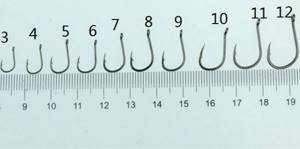
Sinker
You can use a sinker weighing 0.5–3 g. It is attached to the very end of the main fishing line. It is better to mount it using a swivel so that it can be easily replaced. There should be 30 cm from it to the point of connection with a leash 10–15 cm long. You can hang a feeder next to the sinker.
Find out also how to cook crucian carp in the oven in foil.
Spinning tackle
Considering that crucian carp is not a big fish, although it can grow to a respectable specimen, then you will have to select only the minimum size bait. A very important factor is the choice of rod and line selection. The main thing is that the tackle allows you to control the bait and record bites.
Rod

If you plan to fish with very small baits, then the rod must be appropriate. The test of such a rod should not exceed 5-7 g. The action of the rod is super fast or fast, and the length of the blank cannot exceed 7 feet. This is a rod with a Solid Tip tip, which is also very flexible, otherwise it will not be possible to control the bait and record very thin bites. Inexpensive models include Aiko Margarite II 195-ULS, Favorite Blue Bird 682 SUL-S, and more expensive ones include Graphiteleader Calzante GOCAX 762-UL-S 0.5-5.
fishing line
Since the tackle must be very sensitive, preference should be given to braided line. A fluorocarbon insert, 0.5 to 1 meter long, which can be located between the bait and the fishing line, will not hurt. In other words, the bait should be attached through a fluorocarbon leader. The strength of the fishing line does not matter much, but still a 2 or 3.5 kg fishing line is just right. You can pay attention to the fishing line Sunline Super PE#0.6, Salmo Elite Braid 0.09, Berkley Nanofit 0.08. Among branded, more expensive ones, you can take braid from Sunline-PE EGI HG #0.4, Rockfish PE #0.3 and PE SWS Small Game #0.2-0.3.
Coil

The reel is also selected depending on the purpose of the gear. In this case, the reel must be of sufficient quality, since thin fishing line is used. In this case, evenness of winding and smooth running are crucial. It is imperative that the reel has a smoothly adjustable friction brake. Inexpensive models such as Okuma RTX, Mitchell Avocet Gold 4 are suitable; among expensive models, you can take Shimano Nasci and Skimano Stradic C14.
Techniques and tactics of catching crucian carp using a spinning rod
After finding a good area for catching crucian carp, you should accurately throw the tackle into a section of the river with dense vegetation. It would be a good idea to feed the chosen place before fishing. It is better to cast at an angle of 90° so that this rather leisurely fish notices the bait.
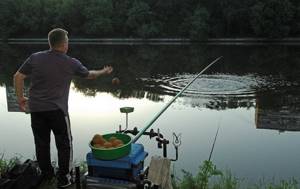
The bait is moved along the bottom slowly, with long pauses (10 seconds or more). When stopping, you need to move it, but so that the weight remains in place. Sudden movements of the bait should be excluded, as the crucian carp may simply get scared of them. In the daytime, almost the same actions are repeated in the water column, and not along the bottom.
Important! When fishing, you should not make strong jerks, so as not to tear off the lip of the crucian carp. A large specimen should be led to the shore under water, and then thrown ashore with a sharp jerk or caught with a net. If you pull up, then this fish, once above the water, will actively twitch and may break off
.
Long casts should be alternated with short ones, as the crucian carp may be near the shore. Reed thickets are especially attractive to him. It often lives at the border of the beginning of this vegetation and swims into the gaps between them. If there is no bite near the shore, then you should make casts to places further away from it, but promising ones.
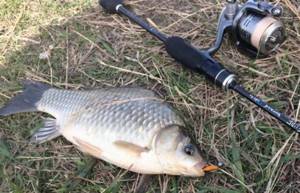
When the crucian carp bites and the line is pulled to the side, do not rush to hook, give it 1-2 seconds to swallow the bait. Then the fishing rod should be moved slightly forward and hooked.
Catching crucian carp with a spinning rod will be exciting and productive if you equip it correctly. An important factor in successful fishing will be a good choice of time and place for it.
Lures for crucian carp
The more actively spring crucian carp feeds on natural animal food, the easier it is to catch it. Although I also remember an interesting episode involving the capture of a crucian carp that was not feeding. I just noticed him in shallow water in the “grass”, the fish froze, his head stuck out a little above the water, it felt like he was lurking in ambush, like a pike. As soon as a miniature turntable was thrown under his nose, he immediately attacked it like a real predator.
For the most part, I fish with rubber – the most reliable option. And it doesn’t have to be small at all. It has happened more than once that crucian carp attacks a two-inch rubber band without hesitation, especially if it is narrow, in the form of a worm or dragonfly larva, in some amazing way often completely swallowing all five centimeters of silicone. But it happens that only inch tires bring good results. Both regular silicone works and edible silicone, which gives off some kind of cheese smell. These “stinkers” also add confidence when fishing for such gourmets as crucian carp.
How to catch crucian carp using a spinning rod
Many fishermen cannot even imagine that crucian carp can be caught using a spinning rod. In this case, we are not talking about a feeder, donk or long-distance casting gear. This is regular fishing with microjig, miniature spinners or jigs, which can easily replace jig heads. All that remains is to find out how to assemble a spinning tackle for crucian carp, what baits to use and how to achieve a good bite.
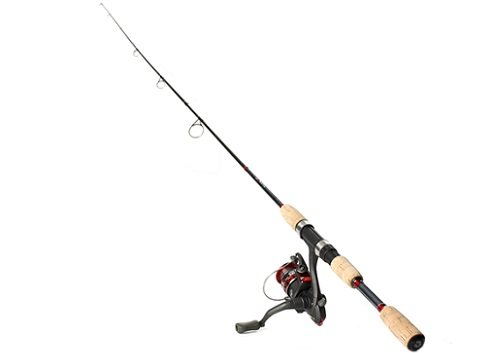
Features by month
When choosing a place for carp fishing with a spinning rod, it is not the month of the year that plays a role, but the weather conditions, air and water temperature. It gets cold in both September and October, but warm November also happens, so it’s better to navigate by the thermometer and barometer.
If in summer fishing begins in the early hours, when the sun is just rising, then in the fall they successfully catch carp on a spinning rod, after the sun rises to its zenith and warms the water at least a little.
September
On most reservoirs, September turns out to be a continuation of the summer months, and carp are not caught with spinning rods, since you can use the usual carp equipment, or a feeder. This is the period when intensive feeding takes place.
October
This month the first frosts begin, the water temperature drops to 10-12º, and fish activity drops significantly. So fishermen pick up spinning rods and go to the reservoirs, trying to catch their luck in the form of a respectable carp. In October, the season closes on most reservoirs, but fishing continues in regions with mild and warm climates.
November
In November, carp are practically no longer caught, not only with spinning rods, but also with other equipment that is considered highly effective during the open water season. Catching carp is possible, but it is more of an accident.
Selection of sinkers for catching crucian carp
For loading a fishing rod for crucian carp, 2-3 lead pellets are best suited. They are often located close to each other, or even right next to each other. Placing them along the entire length of the equipment when using a goose feather float will be impractical and inconvenient. Undoubtedly, the choice of location of the pellets depends on the preferences of the fisherman and everyone places them differently.
There should be about twenty centimeters of distance between the sinker and the hook. Very often, anglers, based on the behavior of the fish in a particular body of water, adjust the distance between the sinker and the hook during the fishing process. If the number of unsuccessful hooks has increased sharply, then you need to move higher from the hook. If the fish eats the bait and the float does not detect the movement of the hook, the sinker must be moved lower.
